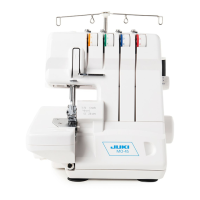
Do you have a question about the JUKI MO-4s and is the answer not in the manual?
| Brand | JUKI |
|---|---|
| Model | MO-4s |
| Category | Sewing Machine |
| Language | English |
Important safety regulations and precautions for operating the sewing machine.
Guidelines for servicing products with double insulation, emphasizing care and qualified personnel.
Identification and description of key parts of the overlock sewing machine.
List of standard and special accessories included with the sewing machine.
Instructions for opening and closing the accessory storage box.
Instructions for opening and closing the looper cover for access.
How to attach and use the waste collector to catch fabric scraps.
Instructions for opening and closing the cloth plate cover.
Steps to connect the foot control pedal to the machine and power outlet.
How sewing speed is adjusted by pressure on the foot control.
Instructions for raising and engaging the thread stand support rod.
Guidance on using anti-vibration cones with different spool types.
Location and operation of the machine's power and light switch.
Description of the handwheel's direction of rotation for manual operation.
How to raise the presser foot using the rear lever.
Step-by-step guide for safely removing and attaching presser feet.
Detailed instructions for safely removing and inserting needles.
Procedure to raise the upper knife for specific sewing operations.
Initial steps before threading, including machine preparation and correct sequence.
Step-by-step guide for threading the upper looper with blue thread.
Step-by-step guide for threading the lower looper with red thread.
Step-by-step guide for threading the right needle with green thread.
Step-by-step guide for threading the left needle with yellow thread.
Final steps after completing all threading, including lowering presser foot and closing covers.
Important note regarding re-threading the lower looper.
Procedure for performing a test run to check stitch formation and thread tension.
How to evaluate the results of the test run for proper stitch formation.
Visual guide on adjusting thread tensions based on loop formation.
Adjusting thread tensions based on fabric type and desired stitch outcome.
How to adjust the stitch length from 1 to 4 mm.
Importance of adjusting cutting width based on fabric type.
Procedure for adjusting the cutting width using the dial.
Using the lever to select between regular and rolled hem sewing.
Explanation of the dual feed dogs and their independent movement.
Using differential feed to stretch fabric and prevent puckering.
Using differential feed to prevent waving or gather fabric.
Setting the differential feed dial to N when not in use.
Using differential feed for gathering single layers of fabric.
Recommended settings for a 4-thread overlock stitch.
Instructions for performing 3-thread overlock stitches with different widths.
How to set up and perform a 3-thread roll hem.
Note on adjusting tensions based on fabric and thread type.
Specific settings for the 3-thread roll hem stitch.
Method for unpicking seams by cutting loops and pulling threads.
Step-by-step guide for safely replacing the sewing machine's light bulb.
How to clean dust and fluff, and where to lubricate the machine.
A guide to common sewing problems and their solutions.
List of achievable stitch types, including overlock and roll hem.
Specifies the recommended needle system (ELx705).
Range of seam widths the machine can create.
Adjustable stitch length for the machine.
Maximum lift height for the presser foot.
Direction of handwheel rotation.
Maximum sewing speed in stitches per minute.
The machine's weight.
Physical dimensions of the sewing machine.
List of standard accessories included with the machine.
List of optional special accessories available for purchase.
